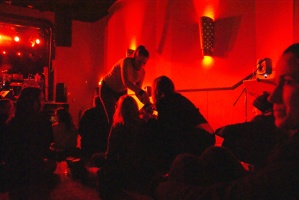(something in capitals)
(something in capitals)
(something in capitals) was commissioned by Solistensemble Phønix16, with support from Hauptstadtkulturfond, Berlin, for first performance by Phønix16 and S.A.F.T. at Columbia Theatre, Berlin, on 30th December 2017. A revised and expanded version was created for Phønix16’s 'Erschrecken kannste morgen' concert at Heimathafen, Berlin, on 31st October 2018, with improv duo NoiserKroiser. The expanded version has also been performed by Piteå New Voices conducted by Sigurdur Arni Jonsson, with Oriol Pares, James Black, Mika Persdotter and Jens Peter Møller at studio Acusticum, Piteå, on 29th August 2019.
The piece is notated as a text score, with vocalists moving between spoken and sung text that diverges and converges around particular vowels or consonants. In the words of conductor Sigurdur Arni Jonsson, "(something in capitals) is slightly tricky and nuanced from a conductor's perspective, as it contains no bars, no determinate pitch or rhythm, but plays with language, spoken sound, timing and timbre in incredibly inventive and fun ways, with a lot of room for interpretation (and failure... or maybe no room for failure)."
Instrumentation:
6 or 12 voices of any range/type, amplified
4 or 8 mini analogue synths (e.g. Korg Monotron, Critter & Guattari Pocket Piano), amplified
2 or 4 multi-band radios, amplified
c. 24 or 48 small or very small bells (cat-collar type), distributed amongst the vocalists
4 or 8 instrumentalists
REVIEW:
Juliana Hodkinson setzt für ihre Uraufführung von (something in capitals) auf eine noch stärkere Verrätselung des Konzertereignisses. Sie arbeitet mit 6 voices of any range/type, amplified, 4 mini analogue synths (e.g. Korg Monotron, Critter & Guattari Pocket Piano), amplified, 2 multi-band radios, amplified, small or very small bells (cat-collar type), distributed amongst the vocalists, and 4 instrumentalists. Die historischen, elektronischen Instrumente haben einen eigenen Reiz. Sie sehen aus, wie die Apparaturen der frühen SciFi-Filme. Die 4 Instrumentalisten befinden sich auf der Bühne, während die 6 Vokalisten an Mikrophonen im Saal stehen, mit den altertümlichen, kleinen Analogsynthesizern und kleinen Glöckchen sich auch im Publikum bewegen. Elektroakustische Musik und Stimmen vom Radio mischen sich mit Stimmen und Instrumenten. Textschnipsel erklingen und brechen ab. Technisch ist die Kombination äußerst vielschichtig und anspruchsvoll. Geht es hier um Hör- und Verstehensprozesse? Vielleicht gibt das „WHAT?“ in der Comic-Sprechblase auf der Website von (something in capitals) einen Wink. Juliana Hodkinson arbeitet auf vielfältige Weise, multimedial mit Sprache und dem Verstehen von Sprache. Sie ist zugleich Poetin. Und sie hat im September 2017 ein Interview mit der Kulturtheoretikerin Georgina Born in Seismograf zu Gender and Social Relations in New Music: Tackling the Octopus veröffentlicht.[5] In der Neuen Musik werden die aktuellen gesellschaftlichen Themen verhandelt. "… my suggestion is that we – and especially all of you as composers, practitioners, performers, curators – should become more conscious of them. This would enable you to be more reflexive about these social dimensions of music, and thereby to take greater reflexive control over them and to work imaginatively with, and indeed to compose, these social dimensions of music – in performance or rehearsal, in the way that members of a music ensemble act in relation to themselves or an audience, or in the relationship with commissioning bodies and other such institutions. Just one of the things this makes possible is to bring gender, race, class and other aspects into the foreground of our consciousness about how music proceeds, and in this way it also makes it possible to experiment with and potentially to transform the ways in which music is social – including the ways in which differences of class, ethnicity, race and gender are played out in music. The challenge posed is to take responsibility for these undercurrent realities, that are so rarely acknowledged: what would music-making – concert life, performance, the influential canons – look and sound like if they were organised differently in these regards?" Was lässt sich also in (something in capitals) hören? Musik machen und komponieren hat nicht zuletzt etwas mit dem Geschlecht in seiner Bedeutungsbreite zu tun, müsste man mit Georgina Born sagen. Born geht es um das Soziale in der Musik. Sprechen da aus den alten Taschenradios nicht nur Männerstimmen in einem bestimmten Duktus, der Wissen generiert? Nun verschwindet zwar das Medium Radio geradezu. Doch im Verschwinden wird möglicherweise noch einmal etwas hörbar, was im Popmedium oder als Pop überhört wurde. Hat sich eigentlich schon einmal jemand gefragt, wie es kommt, dass beispielsweise Tommy Mottola nach Diana Ross, Mariah Carey und Gloria Estefan mit Shakira, Anastacia, Jennifer Lopez und Thalía immer wieder einen sehr ähnlichen Typ Sängerinnen produziert hat? Die Beziehungen zwischen den Musikern und ihrem Publikum sind nicht einfach „natürlich“ oder „spontan“. Vielmehr werden sie durch institutionalisierte Strukturen generiert. - NIghtOut@Berlin





